by Evan Anderson | Oct 14, 2020
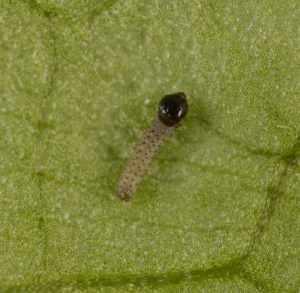
A newly hatched armyworm –photo by Lyle Buss
With a population that never seems to quite disappear in North Florida, the armyworm is a caterpillar pest of many plants. There are four types found in our area: fall, southern, yellow-striped, and beet armyworms. The caterpillars pupate into moths, which breed roughly from April to December, but warmer weather may lead to them being sighted even in the middle of winter. Adult moths, which are relatively nondescript and gray-brown in appearance, lay masses of 100-200 eggs on plants. Young armyworms are tiny and very difficult to detect, often hiding during the brightest parts of the day.
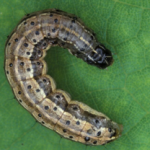
A fall armyworm. –photo by J L Castner
The armyworm grows to a length of about 1 ¼ inches, taking about two weeks to reach its full size. The caterpillar builds a cocoon in the soil and pupates into a moth, living another one to three weeks. With its ability to eat a broad range of plants, this can lead to large populations of these insects in a relatively short time.
Armyworms seem to prefer eating grasses (especially Bermudagrass in lawns), but will chew on almost anything in their path. They have been observed eating citrus trees, tobacco, cotton, strawberries, and even weeds like pigweed and nutsedge. A hungry armyworm might even turn on its fellow caterpillars, eating them as well if they are too close. When large numbers of these pests are present, the damage they do to surrounding foliage can be stark. Young caterpillars may skeletonize leaves, while older larvae will make holes in leaves or defoliate plants fully.
Years with an abundance of wet or humid weather seem to help armyworms reproduce. Armyworms seem to be attracted to newly established turf, and heavy fertilization of turfgrass in late summer can also cause populations to build. Scout for them
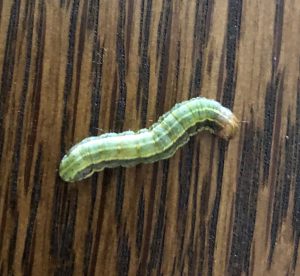
A beet armyworm. –photo by Serena Robison
during cooler hours of the day, or when it is overcast or rainy. Mixing a tablespoon of dishwashing soap in a gallon of water and pouring it over a four-square foot area will cause insects to crawl to the surface – do this if damage is present and armyworms are suspected. For lawns, treatment at the first sight of damage may help, though a lawn may very well survive an attack by armyworms. If chemical control is necessary, there are numerous options. Products containing the active ingredients Bacillus thuringiensis, acephate, bifenthrin, carbaryl, permethrin, spinosad, and others have all been labeled for use on armyworms.
For more information, see our EDIS publication on fall armyworm at https://edis.ifas.ufl.edu/in255 or contact your local Extension office.
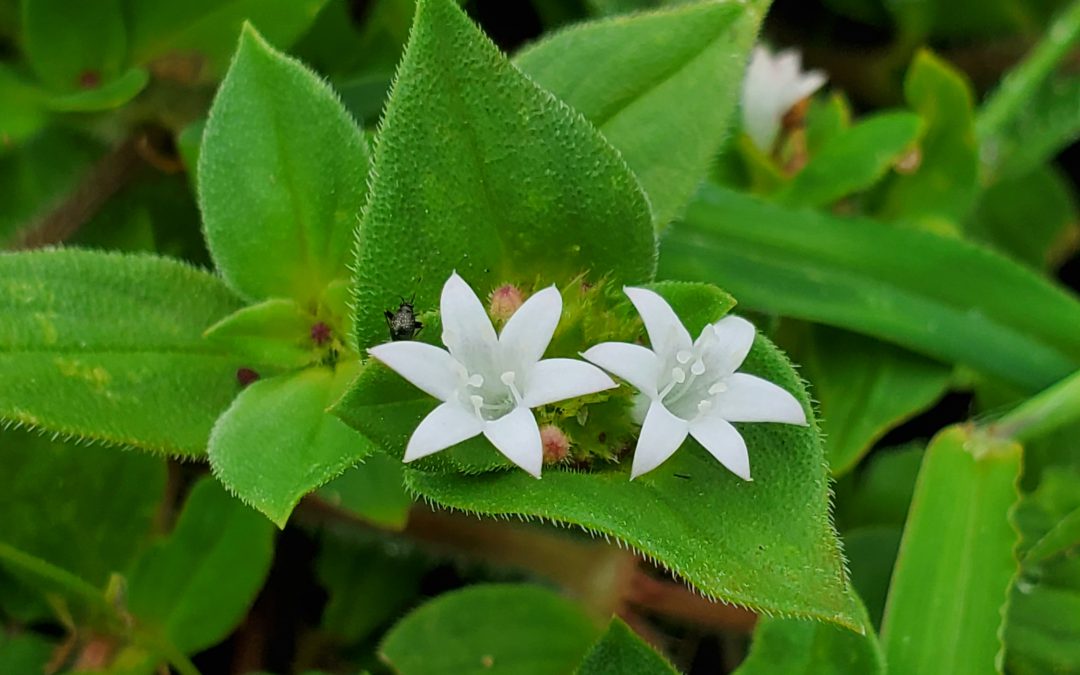
by Evan Anderson | Sep 14, 2020
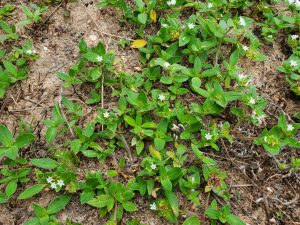
Florida pusley has a low, spreading habit.
Florida pusley and its relatives, Brazilian and large-flower pusley, are common sights in lawns and landscapes during the summer. These prolific and tenacious weeds are closely related species in the genus Richardia, in the Rubiaceae family which includes coffee, bedstraw, and the plant from which the emetic ipecac is derived. With their thick leaves, low and spreading growing habit, and bright white flowers, they can quickly take over bare spots in a lawn and become quite a nuisance.
Because bare spots are a magnet for pusley (and weeds in general), one method to help prevent this weed from becoming a problem is to ensure the turfgrass is as healthy as possible. Well established grass can outcompete many other competitors. Keeping a lawn in tip-top shape includes watering properly, mowing at the recommended height for the grass species and variety, fertilizing appropriately, and controlling pests and diseases in a timely fashion. This can take some work in North Florida’s hot, humid climate, but prevention is almost always easier than trying to cure a problem.
Florida pusley is quickly noticed as soon as it flowers. While some may find the flowers attractive, they set seeds swiftly and before you know it, the next generation of plants is ready to go. Surprisingly, they are also an important nectar plant for honeybees. If chemical control is warranted for an infestation, a pre-emergent herbicide may help. Timing is important for this, so keep an eye on the thermometer – pre-emergents should be applied in the spring (February or March) when temperatures reach 65-70 degrees Fahrenheit for four to five days in a row. Examples are products with active ingredients such as atrazine or pendimethalin, though atrazine should not be used on bermudagrass or bahiagrass.
For weed problems that are already established, there are post-emergent herbicides available. In bahia, bermuda, and zoysia, products containing 2,4-D (or mixtures, such as 2,4-D and dicamba) can work fairly well. These products may require two applications to adequately control pusley. Be aware that some herbicides are sold under trade names that may be confusing, such as Roundup for Southern Lawns, which is a mixture of 2,4-D and penoxsulam, and is labeled for use on bahia, bermuda, St. Augustine, and zoysia grasses . It does not contain glyphosate, and Roundup that DOES contain glyphosate will kill turfgrass as well as weeds. Check the active ingredients on the herbicide label.
In St. Augustine lawns, options are more limited. Homeowners with St. Augustine may want to consider contacting a lawn care company for help with pusley. The available herbicides that are labeled for use in this instance are either difficult to use or prohibitively expensive (The herbicide Celsius, for example, costs over $100 per 10 oz. bottle). Another chemical that is effective is metsulfuron, and while it can be used in bermuda and zoysia lawns as well, it comes with some serious difficulties. First and foremost, it can be taken up by the roots of plants and is NOT safe to use around trees or shrubs. Properly measuring the chemical is tricky, as it may take only a single ounce to treat a whole acre. Serious damage can be done to surrounding plants if it is mixed or used improperly, and as such it may be difficult to find at local stores.
Homeowners who choose an herbicide to control pusley or any weed should be aware that high temperatures during the Florida summer can cause chemicals to affect the grass as well. St. Augustine is especially prone to this, and some herbicides such as 2,4-D may affect grasses more when temperatures rise above 85-90 degrees Fahrenheit.
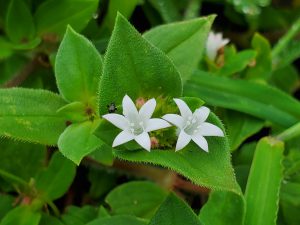
A closeup of Florida pusley flowers.
Treatment of pusley and weeds in general is most effective when the plants are young. Large pusley plants have deeper roots and may take more applications of herbicides to control effectively. Furthermore, of the pusley species that can be found in our area, large-flower pusley is more difficult to control and may be tolerant of some chemicals. For more information, contact your local Extension office.
-Evan Anderson, Walton County Horticulture Agent
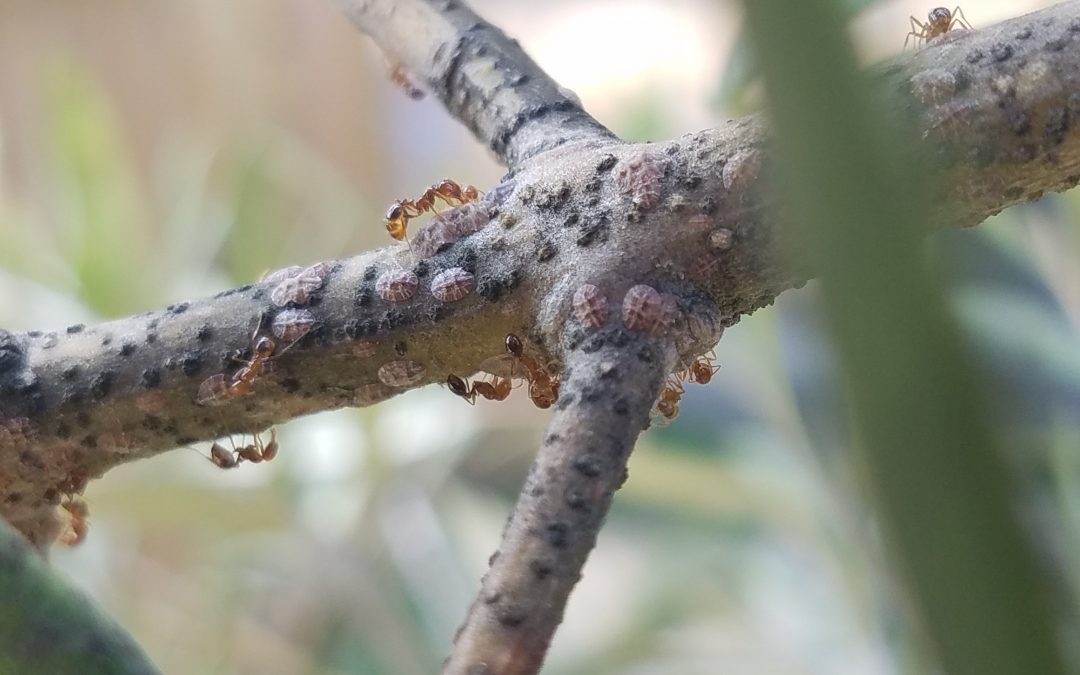
by Evan Anderson | Aug 6, 2020
Nature is full of examples of animals that use camouflage to protect themselves, and some of the best examples are found in the insect world. They may appear to be leaves, sticks, thorns, or flowers; there are insects that disguise themselves as snakes, bird poop, or other more dangerous insects. While many of these adaptations protect them from predators such as birds or spiders, they may also make it difficult to identify a bug that’s causing a problem in the garden!
There are several insect pests of plants that may not appear to be what they are at first glance. This can make frustrating to figure out what’s harming a plant, and identification is a very important first step in solving any problem. Here are some of the more common critters that wear disguises in our area, though.
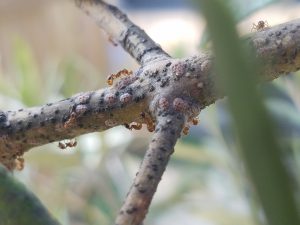
The ants in this picture are attracted by the scale insects, which look like oval bumps on the stem of the plant.
Scale Insects vary in shape, but many of them appear to be simply another bump on the stem or leaf of a plant. They often form a waxy covering over their bodies and stay put, simply feeding in place on the juices within the plant. Ants may notice them, however, and are attracted to the sticky, sugary substance that they exude called honeydew. This honeydew drips onto other stems and leaves, and may grow sooty mold, a black or gray coating that might make one think the problem is fungus. Look for scale insects if you notice these signs (and be aware that other insects such as aphids or mealybugs also produce honeydew).
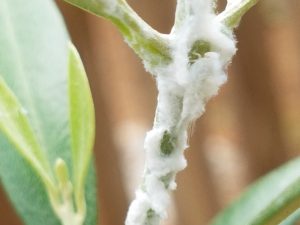
Some psyllids or immature planthoppers cover themselves in white fuzz as protection.
Psyllids, mealybugs, and aphids are all different insects, but some species of each use a waxy coating to protect themselves. This gives them a white, fuzzy appearance that may appear at first glance to be a fungal growth. A close look can reveal the truth – that the fuzz is hiding a plant pest within.
Planthoppers and sharpshooters can be pests of certain plants, including grapes. They may appear to be bumps or thorns on a stem, but usually move or jump if approached.
Caterpillars may disguise themselves in a number of ways. Some may blend in with the foliage that surrounds them, while others appear to be twigs or even the aforementioned bird poop (in the case of the giant swallowtail butterfly, whose larvae enjoy feeding on citrus leaves). It is typically the damage to the plant that is first noticeable. Unlike the other insects mentioned here which feed by piercing into a plant and sucking out the juices, caterpillars have chewing mouthparts. Leaves with holes in them are a good sign that you might have a caterpillar problem.
Remember that not every insect is a pest, and not all pests do enough damage to warrant controlling them. If you need help determining if an insect you’ve seen in your garden or landscape is a problem, contact your local Extension office. You can also find more information on all of these insects and more in our EDIS publications, a few of which are listed below:
Scale insects: https://edis.ifas.ufl.edu/pdffiles/MG/MG00500.pdf
Mealybugs: https://edis.ifas.ufl.edu/in1149
Caterpillars: https://edis.ifas.ufl.edu/topic_landscape_caterpillar_pests
by Evan Anderson, Walton County Horticulture Agent
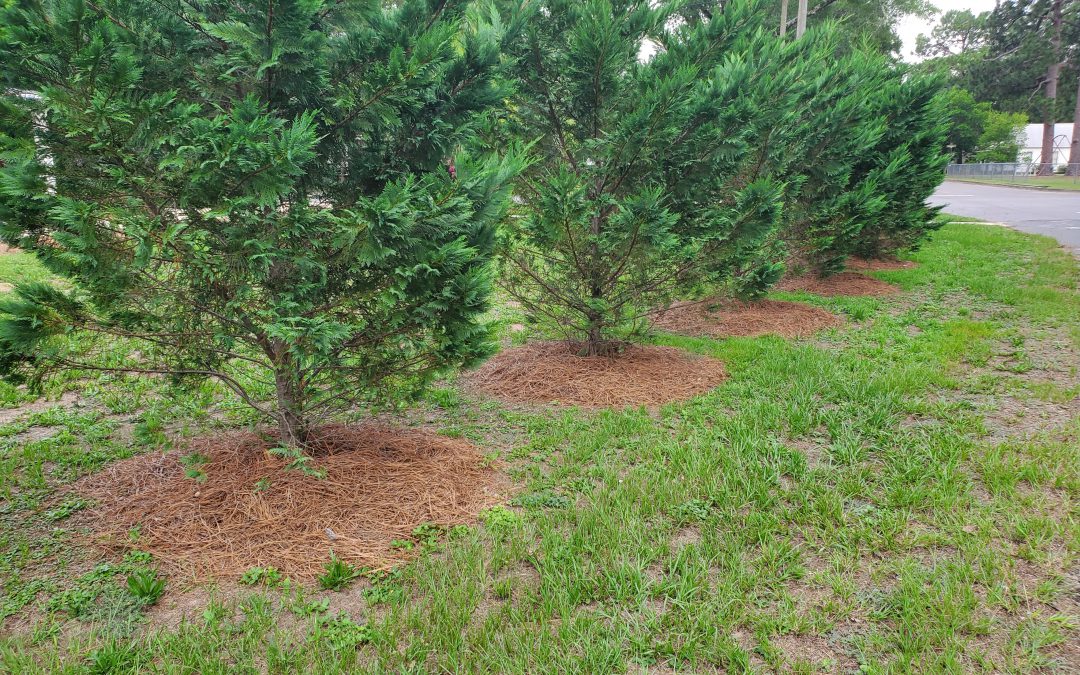
by Evan Anderson | Jul 1, 2020
A lot can go wrong in a garden or landscape, but proper preparation can help to avoid many of these problems from popping up in the first place. For some of these problems, a good preventative measure is mulch.
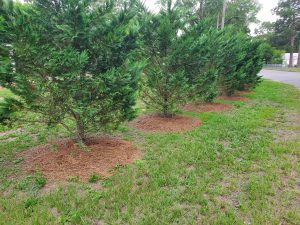
Pine straw is a common material used as mulch.
Mulch is any material that’s spread over the surface of the soil. One of the most common materials used in our area is pine straw, which is simply the needles of pine trees harvested from forested lands. Pine bark, another byproduct of the forestry industry, can be found easily as well. Both of these mulches will tend to have an acidifying effect on soils over time.
Other popular mulches include shredded or chipped wood. Melaleuca trees were originally planted in South Florida in an attempt to convert wetlands into farmable areas; to help remove this invasive species, the trees are now cut and ground into mulch. Eucalyptus mulch is also popular, as well as cypress, though it can be difficult to determine where cypress mulch originated from. Improperly harvested cypress can damage Florida’s natural wetlands. Hardwood mulch from other species may also be found.
Utility companies may sometimes give away mulch produced as they trim trees and bushes along their power lines, but this should be used only with the understanding that it may contain weed seeds or traces of herbicides or other chemicals. Homeowners may sometimes produce their own mulch in the form of raked leaves or grass clippings, but the same concerns about weed seeds and chemicals apply here as well.
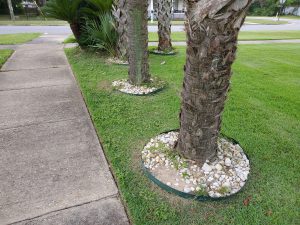
Mulch can be used to help avoid hitting plants with a mower or trimmer.
Gravel or pebbles may often be used, especially in wet areas, or close to houses where flammable materials may be ill advised. Lastly, garden mulches may include materials such as paper or plastic spread in sheets over the ground.
Choosing the proper mulch can depend on the reason for its use. There are a number of effects mulch can have on a garden or landscaping bed. Mulch can help to retain moisture in the soil, keep weed growth down, reduce erosion, and act as a temperature buffer for the soil and plant roots below. It may also add visual appeal and help to keep lawn mowers and trimmers from needing to get too close to plants which may be damaged by them.
Whatever the reasons for adding mulch, there are a few things to avoid. Do not mound mulch around the base of plants. Moisture held against the trunk or stem of a plant can lead to fungal problems. Try to maintain a layer two to four inches deep. Any less and weeds will grow through the material; more mulch will not allow water to filter properly to the ground. Finally, if mulch becomes clumped and matted over time, do not let these block air or moisture to areas below. Rake or stir the mulch to evenly spread it.
You can find more information on mulching at our EDIS site https://edis.ifas.ufl.edu/topic_mulch or in the Florida Friendly Landscaping site at https://ffl.ifas.ufl.edu/handbook/Mulch_vSept09.pdf.
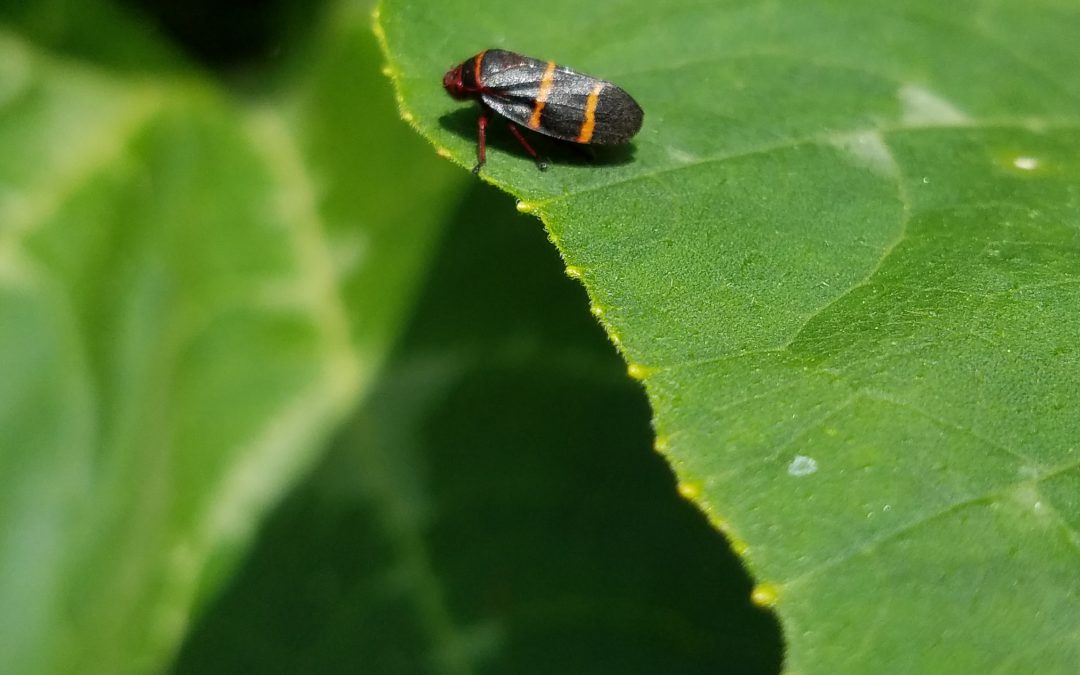
by Evan Anderson | May 27, 2020
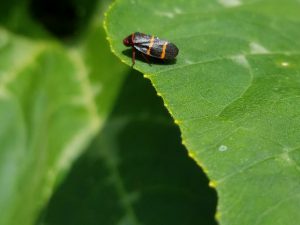
Two-Lined Spittlebug. Photo courtesy of Evan Anderson.
Problems with turfgrass come in all shapes and sizes. One that may affect your lawn is an insect that has two very distinct life stages. Named for the two distinct stripes on its back, the two-lined spittlebug looks like a plant or leafhopper during its adult life. When it is young, however, it is often camouflaged and not readily visible. The small green nymph hides in a mass of white froth or spittle that it secretes for protection.
The two-lined spittlebug is not a picky eater, though it cannot harm people or pets. It feeds on a variety of plants, piercing the stem or leaves with its mouthparts and sucking out the juices within. While it may not be picky, it does have favorites. Holly bushes are one food of choice for this pest and centipedegrass is another, so those growing this grass should keep an eye open. The protective spittle masses are usually close to the ground, so they may not be readily visible from above.
Centipedegrass displays feeding injury from spittlebugs in the form of purple or white striping along its leaf blades. If infestations are particularly heavy, the grass may turn yellow, then brown, and eventually curl up as the leaves die. Populations of the adults that cause most of this damage are typically largest in June, with another spike around August or September as the year’s second generation matures. Years with excess rainfall in spring and summer will see increased numbers of spittlebugs.
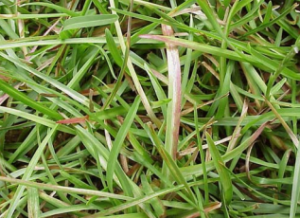
Spittlebug damage on Centipedegrass. Photo courtesy of Larry Williams, Okaloosa County Horticulture Agent.
If you are having a problem with these pests, make sure you are keeping your lawn as healthy as possible with good cultural practices. Proper watering, fertilization, and mowing to the appropriate height can all help to keep grass strong enough to withstand pests. Remove excess thatch, as it holds moisture and can favor the growth of spittlebugs.
Insecticides may be used to help with control as well. Options for Florida include pyrethroids such as bifenthrin, permethrin, and cyfluthrin. Products with the active ingredients imidacloprid and carbaryl are other options. Read the label of any product you choose. If you have questions or need help in identifying a pest problem in your lawn, contact your local Extension office.















